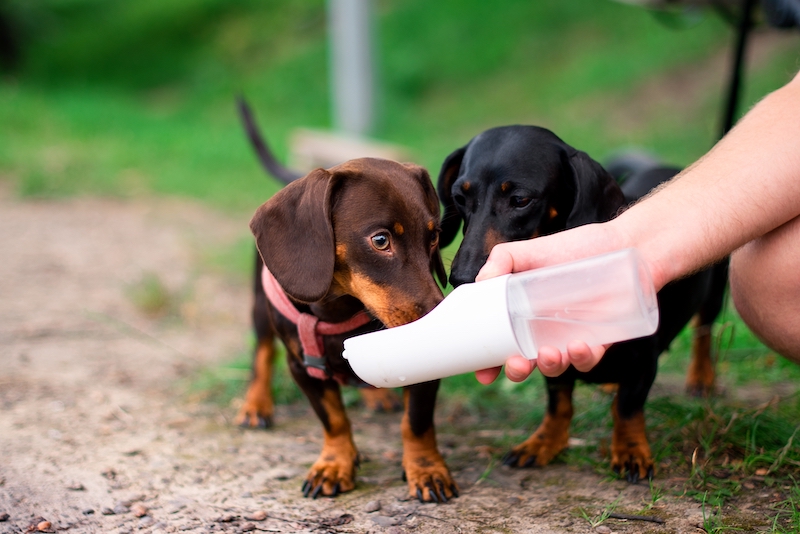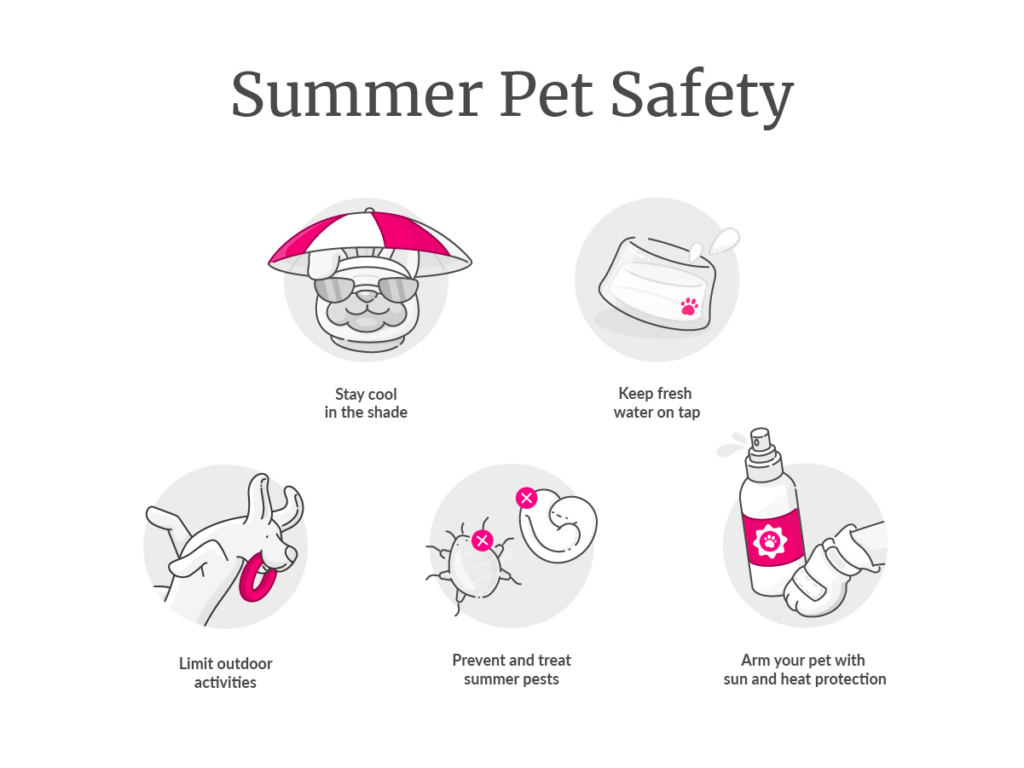- What is heat stroke in dogs?
- What are the signs of heat stroke in dogs?
- What are the causes of heat stroke in dogs?
- How can I prevent heat stroke in my dog?
- What should I do if my dog has heat stroke?
- What are the treatments for heat stroke in dogs?
- Does pet insurance cover the costs of treatment for heat stroke in dogs?
- FAQs about heat stroke in dogs
As the US and beyond face brutal heat waves, the risk of heat stroke in dogs also spikes. Heat stroke can be a life-threatening condition for dogs, so it’s important to take preventative measures, understand the early signs, and have a plan in place to get your pup the care they need right away.
Read on to learn more about how you can help keep your dog happy and healthy in the summer heat.
- Heat stroke in dogs is when a dog’s body temperature rises above 102.2 degrees Fahrenheit, causing their bodily systems to malfunction or shutdown.
- The main signs of heat stroke in dogs to look out for include excessive panting, labored breathing, drooling, vomiting, diarrhea, and appearing unsteady or collapsing.
- In 2025 the average cost of treatment for heat stroke in dogs ranges from about $500 to $1,000, with more severe cases that require a multi-day hospital stay in the ICU costing upwards of $5,000 to $15,000.
- Pet insurance could help cover the cost of your dog’s treatment for heat stroke.
What is heat stroke in dogs?
The American Animal Hospital Association warns that if the core temperature of your pet gets higher than the normal range (100 – 102.2 degrees) they have heat stroke—aka hyperthermia.
Our pets don’t sweat like we do, making them overheat more easily—and with more dangerous consequences.
Heat stroke can impact the ability of your pup’s bodily systems—like clotting, digestion, and oxygen and heat exchange—to function normally. And in severe cases it can lead to organ failure, or sudden death, or the need to euthanize your pet.
While any pet can be at risk for heat stroke, dogs are much more prone to it than cats, since felines usually hang out indoors, or in the shade.
What are the signs of heat stroke in dogs?
There are several clinical signs of heatstroke to look out for, such as:
- Excessive panting
- Difficulty breathing—when your dog is breathing so heavily that you can see their abdomen rapidly expanding
- Diarrhea
- Vomiting
- Salivating or drooling
- Collapsing
- Feeling warm to the touch
- Temperature of over 102.2 degrees
- Blood pressure changes
- Coagulation or clotting disorders, leading to organ dysfunction
Consulting with vet or a professional at a veterinary hospital can help you accurately diagnose your pet’s condition.
What are the causes of heat stroke in dogs?

There are lots of factors that can lead to heat stroke in dogs, including:
- High environmental temperature: The most common cause. Dogs left in hot environments, such as a car, a yard without shade, or a hot room without enough ventilation can quickly overheat.
- High humidity: Makes it harder for dogs to cool down through panting, increasing the risk of heat stroke.
- Not enough water: Dogs need constant access to fresh and cool water, especially during hot weather. Dehydration can quickly lead to overheating.
- Overexertion: Strenuous exercise during hot weather, especially without adequate breaks for rest and rehydration, can lead to overheating.
- Short-muzzled, or Brachycephalic breeds: Dogs with flat faces, such as Pugs, Bulldogs, and Boxers, have a harder time panting effectively and are more prone to heat stroke.
- Obesity: Overweight dogs have a higher risk of heat stroke because excess fat can act as insulation and raise their body temperature.
- Age: Both very young puppies and older dogs have a higher risk because their bodies might not be as efficient at regulating temperature.
- Coat type: Dogs with thick, double coats are more prone to overheating because their coats trap heat.
- Coat color: Dark-colored coats tend to absorb more heat from the sun than lighter-colored coats, which can lead to an increase in body temperature
- Underlying health conditions: Certain health issues like heart disease, respiratory disorders, or laryngeal paralysis can make a dog more susceptible to heat stroke.
- Certain medications: Some drugs can affect a dog’s ability to regulate their body temperature, increasing the risk of heat stroke. Always consult with your vet about possible side effects of medications.
According to the American Veterinary Medical Association, one of the leading causes of heat stroke in dogs is leaving them in the car. (And leaving the window cracked doesn’t really make a difference.)
A 2020 study in the UK found that exercise can be just as dangerous of a trigger as a hot car.
How can I prevent heat stroke in my dog?

We asked our favorite veterinarian, Dr. Stephanie Liff, for her top tips to help your dog beat the summer heat and prevent heat-induced illness, like heat stroke. Here’s what she recommends:
- On hot days, keep your pets in a cool place as much as possible, especially if you see them panting.
- Your dog should always have access to cold water to drink. Keep a reusable dog bowl handy and take it wherever you go with your dog.
- Avoid taking your dog out during the hottest parts of the day, between dawn and dusk.
- On extremely hot and humid days, limit outdoor play to 5–10 minutes at a time, or until they’re panting heavily. Opt for indoor activities with air conditioning when possible—even if it might take some of the fun out of a game of catch.
- If your dog is a strong and enthusiastic swimmer, letting them take a dip in a swimming pool or lake is a great way to burn energy on a hot day with a lower risk of overheating (as long as they don’t overdo it).
- If you have a rectal thermometer for your pet and have discussed with your vet how to safely take pup’s temperature (and your pet can stay calm while having their temperature taken), you can monitor if their temperature is staying within the normal range. Any temperature over 102.2 degrees means your pet could be starting to overheat, while 104.5 to 105 degrees warrants an emergency vet visit, even if your pet is acting normal.
What should I do if my dog has heat stroke?
If you see signs of your pet having heat stroke, get them to the emergency vet ASAP.
Heat stroke progresses rapidly, and first aid measures at home are not a substitute for veterinary care.
It might feel like a no-brainer to help your pup cool down at home, but you’d be overlooking other complications associated with heat stroke such as organ damage, dehydration, and electrolyte imbalance, and you’d risk sending your dog into shock.
What are the treatments for heat stroke in dogs?

Once you get your pup to the veterinary clinic or animal hospital, your dog’s body temperature will be closely monitored while they are cooled down.
Once stabilized, further treatment will depend on the clinical signs and the severity of the heat stroke. Your dog might require things like:
- IV fluids to treat dehydration and electrolyte imbalances
- Medications to prevent or treat brain swelling, blood clotting issues, gastrointestinal dysfunction, and potential organ damage
- In severe cases, blood transfusions or organ-specific treatments might be necessary
The average cost to treat heat stroke in dogs in 2025 is roughly $500 to $1,000.
More severe cases that require a multi-day hospital stay in the ICU could come with a price tag of $5,000 to $15,000 or more.
Does pet insurance cover the costs of treatment for heat stroke in dogs?
Yes, pet insurance plans often cover treatment for heat stroke, but the extent of the coverage will depend on your specific policy.
For example, a basic Lemonade pet insurance policy could help cover the costs of your dog’s heat stroke treatment, minus your deductible and co-insurance.
If your dog experiences heat stroke once, make sure to closely follow the advice of your vet to prevent your dog from having heat stroke again in the future. If you don’t take the extra precautions that were recommended by your vet and your dog has heat stroke again, their treatment might not be covered by your pet insurance.
Let’s say your pup gets heat stroke after joining you for a Fourth of July 4K fun run in 100 degree weather. Your four-legged running buddy makes a full recovery, but your vet explains the dangers of running extended periods of time in the heat with your pup. Then on Labor Day your pooch joins you for a 5K race when it’s 98 degrees outside and gets heat stroke again. This time around your pet insurance might deny a claim related to the incident.
FAQs about heat stroke in dogs
Can dogs get heat stroke from being in a car?
Can dogs get heat stroke from being overweight?
Yes, obesity is one of the risk factors for heat stroke. Overweight dogs may have extra layers of fat that insulate their bodies and prevent them from cooling down effectively. They might also overexert themselves during exercise or play, causing their body temperature to rise more quickly, making it crucial to maintain a healthy weight for your pet, particularly during the hot summer months.
Can dogs get heat stroke from old age?
Yes, older dogs are at a higher risk. As dogs age, their ability to regulate body temperature can decrease, and they may have other health conditions that make them more susceptible to heat. They also may not be as capable of moving to a cooler area if they get overheated, so it’s especially important to take extra precautions to prevent heat-related illnesses in senior dogs.
A few quick words, because we <3 our lawyers: This post is general in nature, and any statement in it doesn’t alter the terms, conditions, exclusions, or limitations of policies issued by Lemonade, which differ according to your state of residence. You’re encouraged to discuss your specific circumstances with your own professional advisors. The purpose of this post is merely to provide you with info and insights you can use to make such discussions more productive! Naturally, all comments by, or references to, third parties represent their own views, and Lemonade assumes no responsibility for them. Coverage and discounts may not be available in all states.




